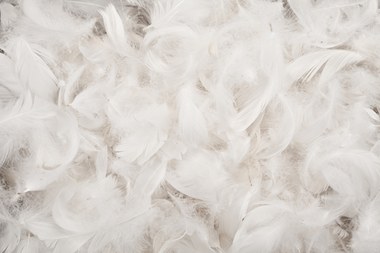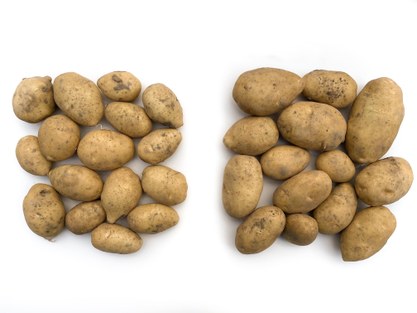Chicken feathers turned into biostimulant for crops
The same quality and yield of harvest with less fertiliser, even in periods of drought. With Aphasol, a biostimulant developed by Stam Agro in cooperation with Ghent University, this is no longer fiction, but reality. As the icing on the cake, the biostimulant is being developed on the basis of chicken feathers, a residual flow that is traditionally regarded as a problem, but is in fact brimming with proteins.
Stronger plants, less fertiliser, lower CO2 emissions
A biostimulant is a product of natural origin that makes plants grow better and stronger,' explains Kris Audenaert, professor of plant and crop sciences at Ghent University. Typically, you can apply them in low concentrations, but nevertheless they have a great effect. They ensure that plants can absorb nutrients better, become more resilient, and can therefore defend themselves better against extreme weather conditions such as drought or prolonged heat. In times of climate change, this is no unnecessary luxury.
Our region is known for its large vegetable and potato processing companies, because we get high yields per hectare here. If the climate were to change fundamentally, it would be a greater challenge to achieve those high yields. Large-scale tests with initial versions of Stam Agro's product showed that by applying this biostimulant with 70% of the conventional nitrogen fertilisation, we can generate similar yields to those with 100% fertilisation," says Vaast Vanoverschelde, founder of Stam Agro, enthusiastically. With ever-stricter standards on nitrogen emissions and fertiliser use, biostimulants can help realise the ambitions of both Flemish and European policymakers. At both levels, the emphasis is on more sustainable cultivation and less use of fertilisers.
‘A biostimulant is a product of natural origin that makes plants grow better and stronger'- Prof. Kris Audenaert
At the same time, policy is pushing hard for the valorisation of residual streams for new applications. The good thing is that the source of this biostimulant - chicken feathers, traditionally considered as residual waste - is available in large quantities,' says Vanoverschelde. With the amount of chicken feathers we can "treat" multiple times the current potato acreage in Belgium. We will complete the circle by also studying the residual products from these processes, and finding relevant applications for them, for instance in animal feed.
To complete the story, this biostimulant ensures an enormous CO2 reduction. Its use on the total potato crop in Belgium could potentially mean a reduction of 55,493 tonnes of CO2 per year. That is the equivalent of the annual CO2 emissions of 22,743 cars.
Chicken feathers to biostimulant
As a company, we focus on the valorisation of waste streams from the poultry sector. Growing a chicken costs a lot of money. It would be a shame to throw away all that investment in chicken feathers, because they are full of protein,' argues Vaast Vanoverschelde of Stam Agro. You just have to find a way to make sense of it, because the average organism can't digest it.
Stam Agro has developed a method for breaking down the protein chains in chicken feathers. The company has already created various applications, including for the aquaculture sector, where they use the proteins instead of fishmeal to breed fish, but also in dog and cat food. Vaast Vanoverschelde: 'We soon realised that free, soluble proteins are also produced during this process, which we can use as biostimulants.
At Stam Agro the feathers undergo an initial physical-thermal pre-treatment,' explains Katleen Raes, professor of food technology at Ghent University. This ensures that the chicken feathers are largely broken down into the free amino acids that are needed to develop the biostimulant. The big disadvantage is that an undesirable conversion occurs during that process: those amino acids, which are normally well absorbed by plants, can be absorbed much less efficiently by the crops. Our role is to use a gentler process, with the use of enzymes, to solve that problem.
But we are also looking further into how the biostimulant works,' says Professor Audenaert. In order to understand it better, we study the growth of plants in a non-destructive way. We irradiate them with a very broad spectrum of wavelengths, so we indirectly know what is happening chemically in the plants: do they absorb nutrients better, do they grow more efficiently, ... This way you can see whether the biostimulant works or not. And if so, when does it work best - does it benefit the plant mainly in a young stage or in a later stage? That is very important for later applications in agriculture.
Towards a biostimulant 2.0
What started as a small-scale test project in small vegetable gardens grew into a multidisciplinary collaboration between Stam Agro and Ghent University. There were already contacts with Ghent University to test the first versions of the product,' explains Vaast Vanoverschelde. But along the way, the trust between the two parties has also grown. And the fact that we could call on the expertise of different research groups meant that together we were able to roll out a complete trajectory, from strengthening and purifying the current biostimulant to better understanding its functioning. I don't think other research institutions can offer such a broad expertise.
Ghebnt University business developers Maaike Perneel and Nathan De Geyter brought together the research groups of professors Erik Meers, Katleen Raes, Geert Haesaert and Kris Audenaert to further study the various aspects of the problem. As business developers of the Industrial Research Fund (IOF), they guide research groups in cooperating with companies and help organisations to obtain funding for further research. The subsidy we received from the Flemish Agency for Innovation and Enterprise (VLAIO) certainly accelerates the research and product development,' says Vanoverschelde. This allows us to make a big difference in a relatively short period of time. The goal is to bring an improved version of the current product to the market in 2024, Aphasol 2.0. And because of the smooth cooperation with Ghent University and the promising results of the first tests, we are even looking at developing the technology together in a spin-off that will focus on the production of bio-simulants based on chicken feathers.

